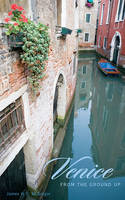
Venice from the Ground Up
Seiten
2006
The Belknap Press (Verlag)
978-0-674-02333-8 (ISBN)
The Belknap Press (Verlag)
978-0-674-02333-8 (ISBN)
- Titel ist leider vergriffen;
keine Neuauflage - Artikel merken
Venice came to life on spongy mudflats at the edge of the habitable world. This book recreates this world-turned-upside-down, with its waterways rather than roads, its boats tethered alongside dwellings, and its livelihood harvested from the sea. Its narrative follows both a chronological and geographical organisation.
Venice came to life on spongy mudflats at the edge of the habitable world. Protected in a tidal estuary from barbarian invaders and Byzantine overlords, the fishermen, salt gatherers and traders who settled there crafted an amphibious way of life unlike anything the Roman Empire had ever known. In an astonishing feat of narrative history, James H. S. McGregor recreates this world-turned-upside-down, with its waterways rather than roads, its boats tethered alongside dwellings, and its livelihood harvested from the sea. McGregor begins with the river currents that poured into the shallow Lagoon, carving channels in its bed and depositing islands of silt. He then describes the imaginative responses of Venetians to the demands and opportunities of this harsh environment - transforming the channels into canals, reclaiming salt marshes for the construction of massive churches, erecting a thriving marketplace and stately palaces along the Grand Canal. Through McGregor's eyes, we witness the flowering of Venice's restless creativity in the elaborate mosaics of St.
Mark's soaring basilica, the expressive paintings in smaller neighbourhood churches, and the colorful religious festivals - but also in theatrical productions, gambling casinos, and masked revelry, which reveal the city's less pious and orderly face. McGregor tells his unique history of Venice by drawing on a crumbling, tide-threatened cityscape and a treasure-trove of art that can still be seen in place today. The narrative follows both a chronological and geographical organisation, so that readers can trace the city's evolution chapter by chapter and visitors can explore it district by district on foot and by boat.
Venice came to life on spongy mudflats at the edge of the habitable world. Protected in a tidal estuary from barbarian invaders and Byzantine overlords, the fishermen, salt gatherers and traders who settled there crafted an amphibious way of life unlike anything the Roman Empire had ever known. In an astonishing feat of narrative history, James H. S. McGregor recreates this world-turned-upside-down, with its waterways rather than roads, its boats tethered alongside dwellings, and its livelihood harvested from the sea. McGregor begins with the river currents that poured into the shallow Lagoon, carving channels in its bed and depositing islands of silt. He then describes the imaginative responses of Venetians to the demands and opportunities of this harsh environment - transforming the channels into canals, reclaiming salt marshes for the construction of massive churches, erecting a thriving marketplace and stately palaces along the Grand Canal. Through McGregor's eyes, we witness the flowering of Venice's restless creativity in the elaborate mosaics of St.
Mark's soaring basilica, the expressive paintings in smaller neighbourhood churches, and the colorful religious festivals - but also in theatrical productions, gambling casinos, and masked revelry, which reveal the city's less pious and orderly face. McGregor tells his unique history of Venice by drawing on a crumbling, tide-threatened cityscape and a treasure-trove of art that can still be seen in place today. The narrative follows both a chronological and geographical organisation, so that readers can trace the city's evolution chapter by chapter and visitors can explore it district by district on foot and by boat.
James H. S. McGregor is co-head and professor in the Department of Comparative Literature at the University of Georgia.
| Erscheint lt. Verlag | 31.10.2006 |
|---|---|
| Zusatzinfo | 110 colour illustrations, 25 halftones, 10 maps |
| Verlagsort | Cambridge, Mass. |
| Sprache | englisch |
| Maße | 161 x 235 mm |
| Gewicht | 836 g |
| Themenwelt | Sachbuch/Ratgeber ► Geschichte / Politik ► Regional- / Landesgeschichte |
| Reiseführer ► Europa ► Italien | |
| ISBN-10 | 0-674-02333-1 / 0674023331 |
| ISBN-13 | 978-0-674-02333-8 / 9780674023338 |
| Zustand | Neuware |
| Haben Sie eine Frage zum Produkt? |
Mehr entdecken
aus dem Bereich
aus dem Bereich
individuell reisen mit vielen praktischen Tipps
Buch | Softcover (2024)
Michael Müller (Verlag)
28,90 €


